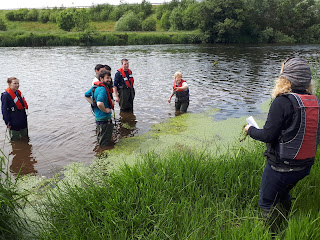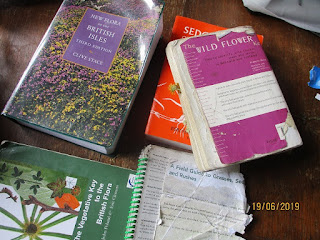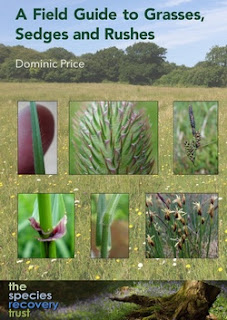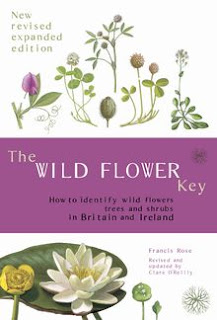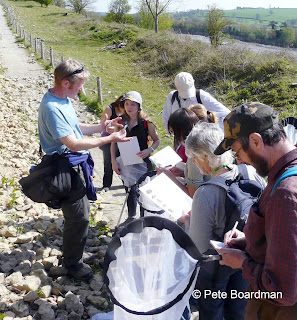LM: So Mike, you took up your new post in May. Before you
tell us about the project and your role, can you tell us a bit about yourself -
what were you doing before you joined Plantlife?
MW: Before Plantlife I was a trainee at the Natural History
Museum for one year followed by a three-year stint with London Wildlife Trust
as one of their Conservation Ecologists. Spending time in the big city taught
me a lot about urban ecology the challenges it faces and how wildlife, and
particularly plants, are adapting to a rapidly changing environment. Looking further back, I’ve always been a wildlife fanatic
but that passion really came into its own when I saw my first bee orchid and
ever since then, I’ve been hooked! For the last 18 years I’ve criss-crossed the
country in search of our wild orchids; studying them, recording them and
photographing them.
LM: Ok so you really know your orchids! Now can you tell us
about Plantlife’s
project to collate Lesser Butterfly Orchid records?
MW: The project is all about trying to halt and reverse the
decline in the Lesser Butterfly Orchid Platanthera bifolia. It’s a Back from
the Brink Project being led by Plantlife alongside a wide range of other
projects all designed to save our most threatened species from extinction. This delicate little beauty has seen a 75% decline across
the British Isles over the last 50 years, enough to place it firmly in the Red
Data List ‘Vulnerable’ category. This means we need to act now to save it from
extinction.
MW: As the project officer, my role is to entirely immerse
myself in the world of the Lesser Butterfly Orchid and pack as much as I can
into the next year, whether it be delivering talks, carrying out monitoring or
advising landowners - it all helps towards spreading the word.
LM: So what exactly are the orchid hunters being asked to do
– and why?
MW: Well a key aspect of the project is to get a better
understanding of how the Lesser Butterfly Orchid is doing right now. The best
way to do this to urge anyone and everyone to go out and record this species
wherever they find it! We want to know how many plants you find, where you find
them and what types of habitat you find them in. All of this information
provides vital pieces to the puzzle in understanding what exactly is going on.
We can then start to formulate what the drivers of the decline might be and
what can be done to help.
LM: LBO distribution across Britain and Ireland is a bit
uneven – there are many parts of England with lots of botanists on the ground
but as this distribution
map suggests, the chances of them finding a LBO are slim. On the other
hand, there are lots of records from north-west Scotland where there are fewer
botanists around to check if the orchids are still there and how they are
doing. Short of moving botanists en masse from the English midlands up to the
Hebrides – how do you plan to face that challenge?
MW: We’re aiming to overcome this hurdle by appealing not
just to botanists but to the entire general public. Anyone who likes to take
the dog for walk or go for stroll can become a recorder – we just need to get
the word out using the combined strength of the BSBI, Plantlife and local media
to raise awareness of the Lesser Butterfly Orchid.
This is the essence of citizen science – getting the public to become the scientists and thus massively expanding the potential reach.
This is the essence of citizen science – getting the public to become the scientists and thus massively expanding the potential reach.
LM: And can you remind people how to ID the Lesser Butterfly
Orchid and make sure they are not looking at Greater Butterfly Orchid which –
as this distribution map
shows – is more frequent in southern and central England?
MW: This is often one which can confuse people but once you
get to know them, it can be fairly easy. In short, it’s all about the two
pollen sacks (called pollinia) which sit in the middle of the flower. The
Lesser Butterfly orchid has pollinia which are parallel to each other and very
close together (almost touching) whereas the Greater Butterfly Orchid has
divergent pollinia which are spaced widely apart. Once you become an ace Butterfly Orchid Zen Master, you’ll
be able to tell them apart without checking the pollinia because Greater
Butterfly is generally a larger-flowered plant with curved tepals whereas the
Lesser has smaller daintier flowers with straighter tepals.
People can also download this
factsheet or look at these
images And if people have ID’d their orchid by looking at the pollinia but
they’d like to double-check, they can take a look at my ‘Beginner’s
Vegetative Guide to Orchids of the British Isles’.
MW: All the Lesser Butterfly Orchid records will find their
way to the database as Plantlife has an active and effective data sharing agreement
with the BSBI. Anyone who sends in their
records will also be contributing to the much-anticipated Atlas 2020
publication.
LM: Some readers may recognise your name from social media
where you often tweet about orchids and share some fabulous photos of them! Can
you remind people how they can follow you on social media?
MW: If you want to follow me personally on Twitter then
search @Leptochila - the scientific species name for the Narrow-lipped
helleborine in case anyone wondered!
LM: And if anybody finds a LBO and takes a photo of this
gorgeous plant, we’d love them to share it on social media tagging you and
@BSBIbotany and including the hashtag #MyLesserButterflyOrchid. I can’t wait to
see those photos!
LM: A little bird tells me that you are working on another
orchid book – can you tell us something about that please?
MW: Myself and Sean Cole (on left) are currently in the final stages
of pulling together a new guide book for Princeton University Press. The idea
of this book is to provide the public with the most comprehensive
identification guide to our 50+ species. Building on previous fantastic guides
developed by the likes of Simon Harrap and Derek Ettlinger, we want help people
with the identification of orchids at all stages of development – leaf, bud,
flower and seed. Progress has been slow but the finishing line is now in sight.
The aim is to have the book published by April 2020.
 |
| Mike aka speccy 6'4" guy |
You can also follow the Britain’s Orchids Twitter account:
@Britainsorchids (run by Sean) and Instagram account: @britains_orchids (run by
me). Watch this space!
LM: Mike, thank you so much for talking to us about this
project and why we should all get involved. And for providing the great photos on this page!
Any chance that you’ll be able to
make it along to this year’s BSBI Exhibition Meeting
and offer a poster about the Lesser Butterfly Orchid and how this year’s survey
has gone? And there will be lots of orchid lovers present who will be keen to
hear more about your forthcoming book!
MW: I’ll definitely be there! Look out for the speccy 6 foot
4 guy lingering around the orchid stalls. It would be great to see you all
there in November.
LM: Great, we’ll look forward to seeing you then – and
meanwhile let’s all go out and record as many Lesser Butterfly Orchids as we
can find!

